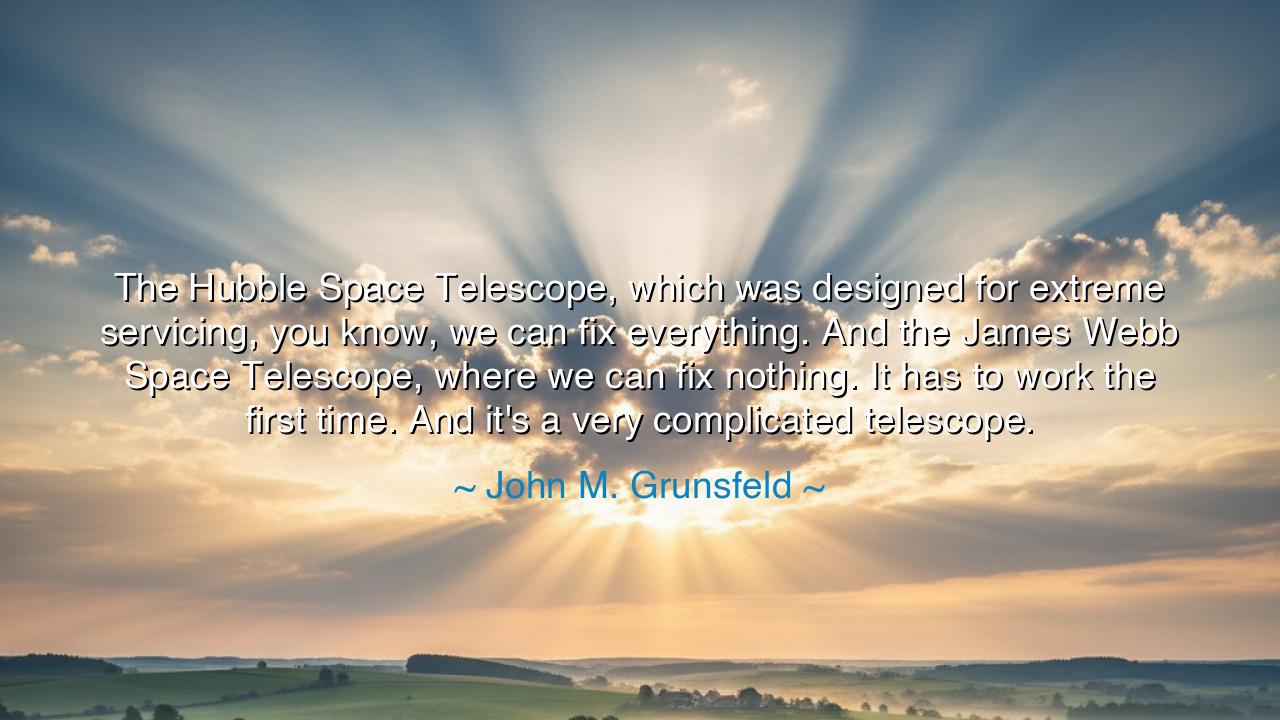
The Hubble Space Telescope, which was designed for extreme
The Hubble Space Telescope, which was designed for extreme servicing, you know, we can fix everything. And the James Webb Space Telescope, where we can fix nothing. It has to work the first time. And it's a very complicated telescope.






Hear, O seeker of wisdom, the words of John M. Grunsfeld, astronaut and guardian of the heavens: “The Hubble Space Telescope, which was designed for extreme servicing, you know, we can fix everything. And the James Webb Space Telescope, where we can fix nothing. It has to work the first time. And it’s a very complicated telescope.” In this contrast between Hubble and Webb lies a parable of human endeavor—the difference between a creation that can be healed by human hands and one that must succeed in its first breath, with no second chance.
The Hubble, launched in 1990, was a triumph of vision and perseverance. Yet it stumbled at its birth: its mirror, ground with exquisite precision, was flawed by the tiniest of errors. The stars it revealed were blurred, and disappointment spread across the Earth. But hope was not lost, for the telescope was made for servicing. Brave astronauts carried tools into orbit, and with their labor, they healed the wounded eye of Hubble. From that day forth, Hubble gave humanity visions of galaxies and nebulae that stirred the soul and changed our understanding of the cosmos.
But the James Webb Space Telescope (JWST), conceived as Hubble’s successor, is a different creation. It cannot be visited, cannot be repaired, cannot be touched once it leaves the Earth. Placed a million miles away at the Lagrange point, it lies beyond the reach of any mechanic’s hand. For Webb, there is no room for failure: its mirrors must unfold perfectly, its sunshield must stretch without flaw, its instruments must awaken as planned. As Grunsfeld says, “it has to work the first time.” This is both awe-inspiring and terrifying: the embodiment of human daring, the test of our ability to create perfection in a universe that knows no mercy.
This truth is not confined to telescopes. Throughout history, humanity has known projects that could be repaired, and others that allowed no second chance. The Apollo 11 mission was one such endeavor. When Armstrong and Aldrin descended to the Moon, they carried no guarantee of return. The Eagle lander’s systems had to work the first time, for no rescue was possible. Failure would have meant eternal silence on that gray world. And yet, through preparation, precision, and courage, humanity triumphed, and the Moon received our footsteps.
Grunsfeld’s words remind us also of life itself. There are times when our choices can be repaired, when we stumble but rise again, when others can help us fix what is broken. These are our “Hubble” moments, when failure is not final, but part of the path to greatness. But there are also “Webb” moments, when the decision cannot be undone, when the leap must be perfect, when all hangs upon a single chance. In such moments, one must be ready, for hesitation or error brings consequences that cannot be mended.
The lesson is thus: cherish the times when you can learn through failure, for they prepare you for the times when failure is not an option. Build your character, your craft, and your vision in the “Hubble” seasons of life, so that when the “Webb” season arrives, you will be strong enough to succeed. For every great endeavor, whether telescope or human destiny, passes from trial-and-error to the one leap that must not falter.
So I say to you, O child of tomorrow: live with both humility and resolve. Learn from your mistakes when life grants you second chances, and be diligent in preparing for the moments when no second chance will come. Remember Grunsfeld’s wisdom: some creations can be fixed, and others must be born flawless. And in this balance of risk and resilience lies the story of human greatness—our striving to see farther, to reach higher, and to touch the very edge of eternity.






AAdministratorAdministrator
Welcome, honored guests. Please leave a comment, we will respond soon